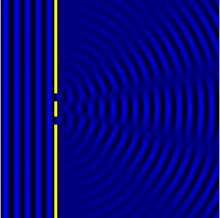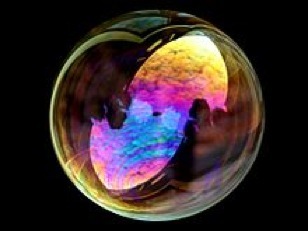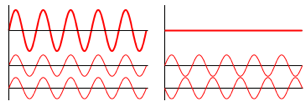The University of Vermont
Physics Department


The University of Vermont
Physics Department
Diffraction And Interference
The phenomena of diffraction occurs for all waves. Diffraction describes the event of waves encountering an obstacle and the consequential bending around the object. Additionally, waves may interfere both constructively and destructively resulting in different wave patterns. The most common example of diffraction occurs with water waves which bend around a fixed object. Light bends similarly around the edge of an object. The animation shows wave fronts passing through two small openings. They visibly change direction, or diffract, as they pass through the opening.

Interference is the phenomena of two waves meeting and adding together to form a resulting wave that is the sum of the heights of each wave where they meet. . When two waves interfere to create a larger peak, it is referred to as constructive interference. When waves interfere to cancel each other out or create a resulting wave with a decrease in height, it is referred to as destructive interference. The lower graphic shows the resulting waveform for two waves in phase and out of phase. The in-phase waves are interfering constructively while the out-of-phase waves are interfering destructively.



The colors in the soap bubble are due to the interference of light reflecting off the front and back surfaces of the soap film. Different wavelengths of light (colors) interfere constructively and destructively due to the varying thickness of the bubble. This effect produces the rainbow of colors. Photo by Mila Zinkova
Waves in phase on the left produce the upper wave when added together. Waves out of phase on the right completely cancel out when added together. Image from Wikipedia
Animation from Wikipedia.
This is the shadow of a steel ball on a post, illuminated by a green laser. The fringes are due to constructive and destructive interference from the edges of the objects. The bright dot in the center proves the wavelike nature of light.